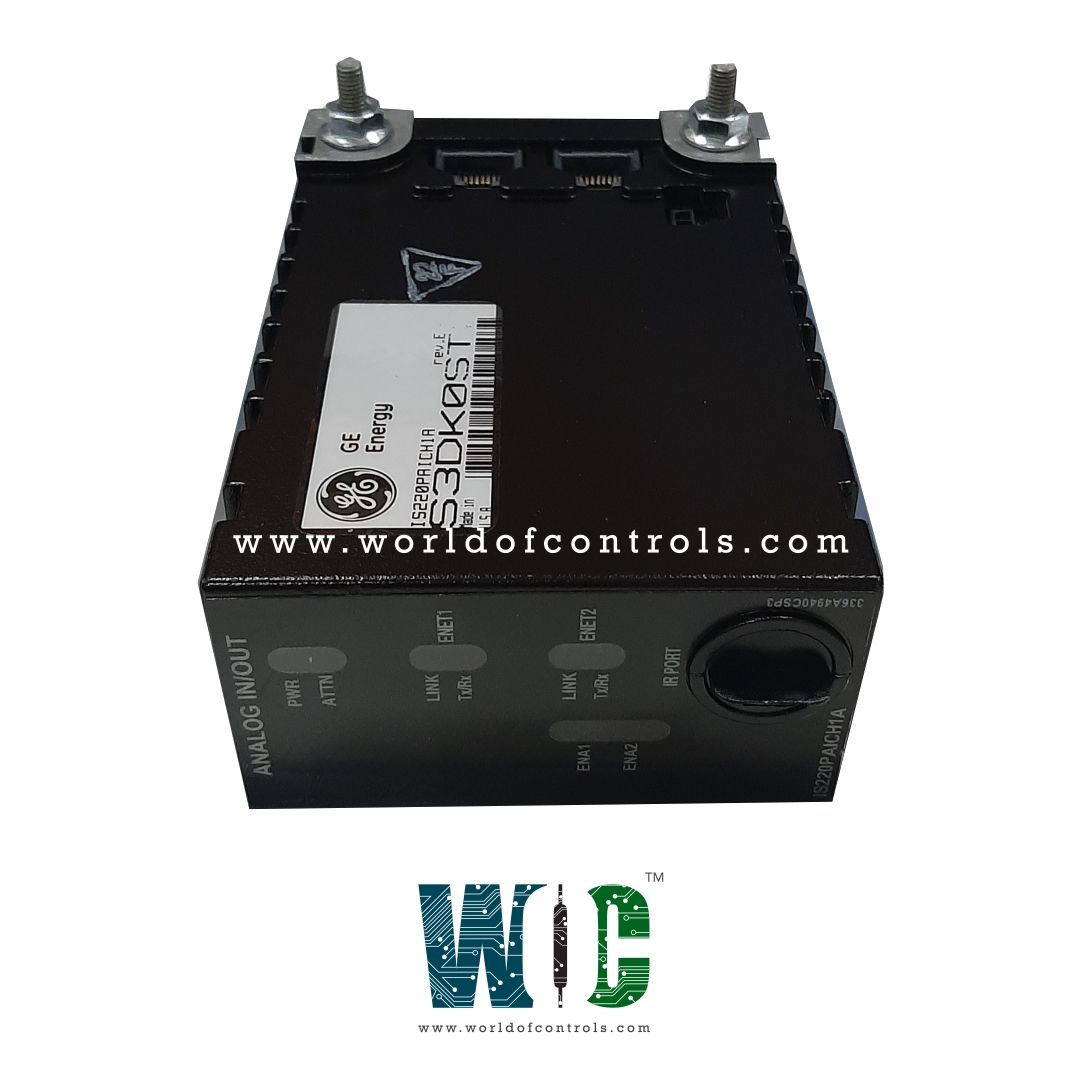
World Of Controls understands the criticality of your requirement and works towards reducing the lead time as much as possible.
IS220PAICH1A, REV D - Analog I/O Terminal Board is available in stock which ships the same day.
IS220PAICH1A, REV D - Analog I/O Terminal Board comes in UNUSED as well as REBUILT condition.
To avail our best deals for IS220PAICH1A, REV D - Analog I/O Terminal Board, contact us and we will get back to you within 24 hours.
SPECIFICATIONS:
Part Number: IS220PAICH1A, REV D
Manufacturer: General Electric
Series: Mark VIe
Product Type: Analog I/O Terminal Board
Operating System: QNX
Power Requirements: +5 V dc, 6 A
Number of input channels: 12
Number of outputs: 125 V dc
Trip Solenoid Rating: 125 V dc
Power supply voltage: 28 V dc
Voltage Range: 18 - 32 VDC
Mounting: DIN-rail mounting
Technology: Surface mount
Operating temperature: 40 to 70°C
Size: 33.0 cm high x 17.8 cm
Repair: 3-7 Days
Availability: In Stock
Country of Origin: United States
Manual: GEH-6721D
FUNCTIONAL DESCRIPTION:
IS220PAICH1A, REV D is an Analog I/O Terminal Board manufactured and designed by General Electric as part of the Mark VIe Series used in GE Distributed Gas Turbine Control Systems. The Analog I/O pack (PAIC) provides the electrical interface between one or two I/O Ethernet networks and an analog input terminal board. The PAIC contains a BPPX processor board and an acquisition board specific to the analog input function. The I/O pack is capable of handling up to 10 analog inputs, the first eight of which can be configured as +5 V or ±10 V inputs or 4-20 mA current loop inputs. The last two inputs may be configured as ±1 mA or 4-20 mA current inputs.
The load terminal resistors for current loop inputs are located on the terminal board, and voltage is sensed across these resistors by the PAIC. The PAICHI also includes support for two 0-20 mA current loop outputs. The PAICH2 includes extra hardware to support 0-200 mA current on the first output. Input to the I/O pack is through dual RJ-45 Ethernet connectors and a three-pin power input. Output is through a DC-37 pin connector that connects directly with the associated terminal board connector. Visual diagnostics are provided through indicator LEDs.
COMPATIBILITY:
The PAICH1A is compatible with the TBAIH1C analog input terminal board and the STAI board but does not support the DIN rail-mounted DTAI board. Control mode defines the number of I/O packs in a signal path:
Although the PAIC can be mounted on TBAIH1A or TBAIH1B terminal boards, it will not achieve full analog signal accuracy due to circuit differences. It is designed for use with the H1C version of TBAI and will indicate compatibility issues if connected to earlier revisions. However, powering a PAIC on an older board will not cause physical damage.
OPERATION:
The processor application code includes all the necessary logic for the pack to function with one or two Ethernet inputs. When using two Ethernet inputs, both network paths remain active continuously, and a failure of one network does not affect the I/O pack operation. The failure is indicated via the active network connection. This setup offers greater fault tolerance compared to traditional hot-backup systems, where the secondary port is only used after detecting a primary port failure. The Ethernet ports on the processor automatically negotiate speeds between 10 MB/s and 100 MB/s and can switch between half-duplex and full-duplex operation.
INSTALLATION:
WOC has the largest stock of OEM replacement parts for GE Distributed Turbine Control Systems. We can also repair your faulty boards and supply unused and rebuilt boards backed up with a warranty. Our team of experts is available around the clock to support your OEM needs. Our team of experts at WOC is happy to assist you with any of your automation requirements. For pricing and availability on parts and repairs, kindly contact our team by phone or email.
What is the typical voltage range for an Analog I/O Terminal Board?
The voltage range typically varies between 0-10V, ±10V, 0-5V, and ±5V, depending on the application. Some boards can support voltage ranges like 0-20mA, 4-20mA, or 0-24V for input signals. Ensure that the voltage range matches the specifications of the sensors or devices you are interfacing with.
What is the sampling rate of an Analog I/O Terminal Board?
The sampling rate indicates how often the board reads or writes data to and from the system. Common sampling rates range from 1 Hz to several kHz, depending on the model. For high-precision applications, choose a board with higher sampling rates to ensure timely and accurate data collection.
What is the input impedance of an Analog I/O Terminal Board?
Input impedance refers to the resistance presented by the terminal board to the input signal. A typical input impedance is 10 M Ohm or higher to prevent loading effects that could alter the signal, especially when measuring high-impedance sources such as thermocouples or strain gauges.